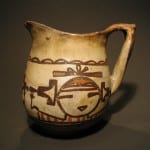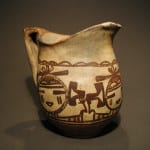A Polacca ware D “milk pitcher” with red bottom and rim and Kachina design ca 1890. This is an important pot illustrating a time of transition from Polacca ware for home use to Sikyatki Revival ware for sale.
In its construction, crackled white slip and red base and rim this is a totally traditional piece of Hopi Polacca ware. Compare pot 1997-09 to Polacca pot 1994-14. (See also, Wade and McChesney, 1981:335 ff.)
Probably the design and certainly the shape of 1997-09 are a response to Anglo market forces. Thomas Keam established the first trading post at Hopi 13 miles east of First Mesa in 1874. Wade and McChesney briefly note that “clown and kachina designs (and) derivation (were) probably introduced by Keam” who certainly encouraged the production of commercial “tiles,” often with kachina designs (1981:596). Joseph Traugott extends the earlier comment by Wade and McChesney: “It seems that the kachina representation on pottery only occurred after the establishment of Keams trading post…circumstantial evidence points to Keam as the popularizer and promoter of mask paintings (1999:16).”
Apparently, Keam felt that the depiction of kachinas would be seen as exotic and attractive to Anglo buyers. The milk pitcher shape is totally foreign to Hopi home-use tradition as is entirely European. One imagines a First Mesa woman after the opening of Keam’s Trading Post trying to use her Polacca ware skills to make pottery (a milk pitcher decorated with “real” kachina designs) that would be purchased by Keam because it would sell to whites. Wade and McChesney capture the tone of the time when pot 1997-09 was produced:
“The history of the Southwest Indian art market has shown repeatedly that Pueblo potters are quick to switch styles when cash incentives are offered. At times the mere suggestion of monetary gain is enough to encourage change. In the poverty-ridden Hopi communities of 1890, any chance to have made a little extra money (or more likely) trade goods would have been seized (1981:455).”
This mixture of Polacca construction and European shape did not compete successfully with the more popular Sikyatki revival designs of Nampeyo and were made for only a short time.
Compare this pot to a similar pitcher with a kachina design made by Priscilla Namingha Nampeyo for sale to the Anglo market 100 years later (2003-03).




